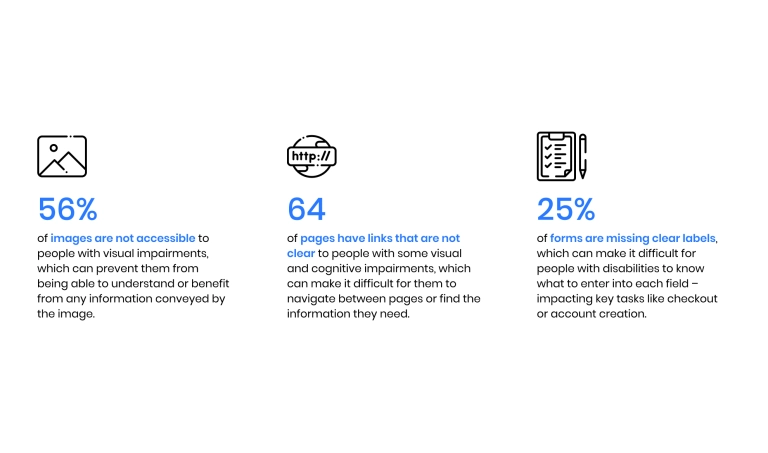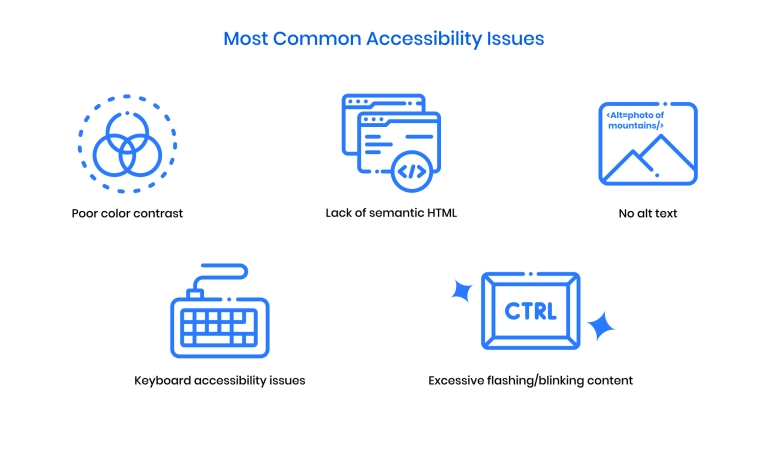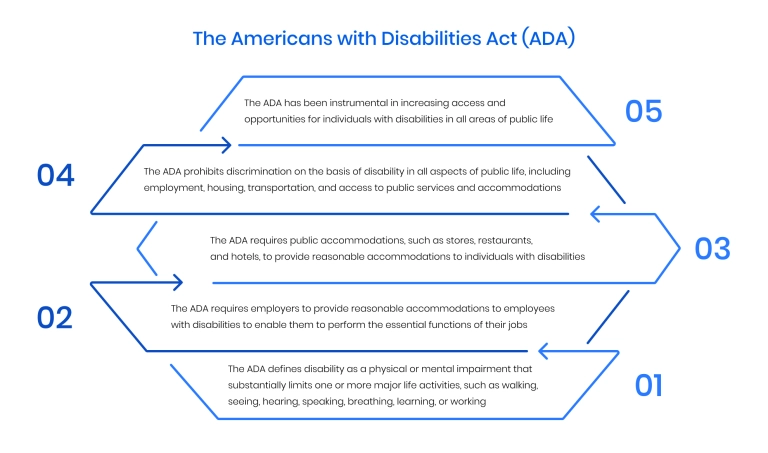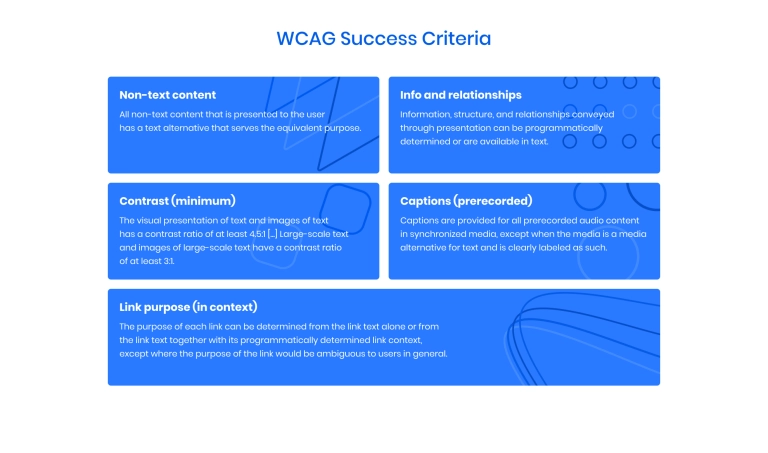Digital accessibility ensures that websites, applications, and digital content are usable by everyone, including people with disabilities. As technology becomes integral to daily life, governments worldwide are updating web accessibility laws to create a more inclusive digital environment. These changes place new responsibilities on businesses to align their digital solutions with accessibility standards or risk penalties and reputational damage.
By 2025, organizations must meet evolving accessibility requirements across regions like the EU, UK, and US. Updated regulations emphasize inclusivity, focusing on compliance with frameworks such as the Public Sector Bodies Accessibility Directive, the UK Equality Act, and the ADA in the US. For businesses operating across borders, achieving website accessibility compliance is essential to avoid risks and provide seamless experiences for all users.
In this article, you'll learn:
- Why accessibility is a critical focus for 2025
- Key updates to web accessibility laws in the EU, UK, and US
- Common challenges in accessibility implementation
- How businesses can align with global standards to stay competitive
Read on to understand how evolving website accessibility compliance requirements impact your business and the steps you can take to meet them effectively.
Why digital accessibility matters in 2025
Digital accessibility is more than just a regulatory requirement — it's a business imperative for 2025 and beyond. New web compliance laws across the EU, UK, and US demand higher standards for inclusivity, making it essential for companies to ensure their digital platforms are accessible to all users, including those with disabilities. Noncompliance risks fines, legal challenges, and reputational harm, but beyond compliance, accessibility creates new opportunities to expand market reach and improve user experience.
In 2023, AudioEye scanned nearly 40,000 websites and found significant accessibility issues among retail sites, directly impacting the shopping experience.

According to Forbes, "Accessibility isn't just a nice-to-have, it's a business driver". For example, cart abandonment is an issue many retailers are already struggling to overcome, with rates currently hovering around 70% globally, according to the Baymard Institute.
Inclusive design not only aligns with website compliance laws but also enhances customer satisfaction and loyalty, particularly as global consumers increasingly value companies that prioritize equity and inclusivity (Source , Source ).

Navigating EU accessibility regulations
The European Union has established comprehensive digital accessibility laws to ensure equal access to digital services for individuals with disabilities. Central to these efforts is the European Accessibility Act (EAA), which outlines specific requirements for digital products and services, such as websites, mobile applications, and e-commerce platforms.
These regulations apply to both private and public entities, aiming to create a more inclusive digital landscape across the EU.
Key requirements under the EU Accessibility Act
- Accessible websites and applications: Companies must meet strict website accessibility standards aligned with WCAG 2.1 Level AA, ensuring compatibility with assistive technologies like screen readers.
- Inclusive digital products: Hardware such as ATMs, ticketing machines, and payment terminals must be designed to accommodate users with disabilities.
- Harmonized design practices: Products and services must adopt universal design principles to be usable by the broadest possible range of people without additional adaptation.
- Customer support accessibility: Businesses are required to offer accessible communication options, including text relay services and alternative contact methods.
According to the European Commission, these measures are part of a broader strategy to promote equality for individuals with disabilities across member states (Source ).
Compliance with the EAA requires ongoing digital accessibility optimization to align existing websites, apps, and systems with regulatory standards.
Understanding the UK accessibility requirements
In the UK, digital accessibility is governed by the Public Sector Bodies Accessibility Regulations 2018, which align closely with the Web Content Accessibility Guidelines (WCAG) 2.1 Level AA.
These regulations apply to public sector organizations, including government websites and mobile applications, requiring them to ensure their digital platforms are accessible to individuals with disabilities. While this law does not directly bind private businesses, many choose to adopt similar standards to meet growing user expectations for inclusivity.
Key requirements under UK regulations
- Accessible websites and apps: Public sector bodies must ensure their websites and mobile apps are perceivable, operable, understandable, and robust for users with disabilities.
- Transparency: Organizations are required to publish an accessibility statement outlining compliance with accessibility standards and detailing areas for improvement.
- Regular testing and monitoring: Continuous evaluation of digital platforms must be conducted to ensure ongoing compliance with WCAG 2.1 Level AA.
While these regulations are specific to the UK, their emphasis on accessibility shares similarities with ADA website accessibility requirements in the US. Both frameworks highlight the importance of inclusivity, with standards that enhance usability for individuals relying on assistive technologies.
Private companies aiming to meet UK accessibility expectations or align with ADA compliance for website accessibility should proactively assess their platforms. By addressing ADA requirements for websites alongside UK standards, organizations can create inclusive web experiences that meet the needs of diverse audiences while mitigating legal risks. For businesses operating globally, adopting such accessibility best practices ensures readiness for future regulations and fosters trust among users.
US accessibility standards: What businesses need to know
In the United States, digital accessibility is primarily governed by the Americans with Disabilities Act (ADA) and Section 508 of the Rehabilitation Act. These laws aim to increase accessibility for individuals with disabilities, ensuring they can fully access digital content and services.
Both frameworks require businesses and government entities to prioritize inclusivity in their digital platforms, aligning with globally recognized standards like the Web Content Accessibility Guidelines (WCAG).
Here are some visuals for better understanding:


ADA standards for digital accessibility
The ADA mandates that websites and digital services be accessible to individuals with disabilities, although it doesn’t explicitly specify technical standards.
Courts often refer to WCAG 2.1 Level AA as the benchmark for ADA compliance. This includes ensuring compatibility with assistive technologies like screen readers, providing alternatives for non-text content, and designing navigable interfaces. Compliance with the ADA is critical for avoiding legal risks and increasing accessibility across a wider audience.
Section 508: Accessibility for federal agencies and contractors
Section 508 specifically addresses digital accessibility for federal agencies, contractors, and organizations receiving federal funding. All electronic and information technology (EIT) developed, procured, maintained, or used by the federal government must meet accessibility standards.
This includes:
- Websites and software: Must be perceivable, operable, understandable, and robust (aligned with WCAG 2.0 Level AA at a minimum).
- Electronic documents: PDFs, Word documents, and other digital files must be fully accessible, with features like screen reader compatibility and alt text for images.
- Hardware and devices: Products like kiosks, phones, or office equipment must be usable by individuals with various disabilities.
Section 508 compliance also extends to continuous testing and reporting. Agencies and contractors are required to conduct regular audits to ensure ongoing accessibility and address any issues proactively. This law serves as a model for improving digital inclusion beyond the federal sphere.
Organizations looking to comply with US standards must adopt a proactive approach to improve accessibility. Regular audits, user testing with assistive technologies, and integrating accessibility features into the design and development process are essential steps. By addressing ADA and Section 508 requirements, businesses can ensure legal compliance, expand their audience, and foster inclusivity.
Optimizing digital solutions for global accessibility compliance
Adapting digital solutions to meet the accessibility requirements of different countries, including the EU, UK, and US, requires a strategic approach that balances global standards with localized compliance needs.
While the mentioned frameworks share common principles, such as adherence to accessible website standards, businesses must tailor their digital platforms to address region-specific rules, such as mandatory accessibility statements in the UK or robust incident response systems under the EU's directives.
For scaling businesses for accessibility, organizations should adopt centralized accessibility frameworks while allowing for localized adjustments. This includes implementing automated tools for testing and monitoring compliance, designing universally accessible interfaces, and integrating assistive technology support.
Key steps for global accessibility compliance
- Understand regional regulations: Familiarize yourself with EU directives, UK accessibility laws, and US mandates like the ADA and Section 508.
- Implement universal standards: Ensure digital platforms adhere to WCAG 2.1 Level AA guidelines for compatibility with assistive technologies.
- Leverage automated testing tools: Regularly assess websites and applications for issues like navigation gaps, missing alt text, or contrast errors.
- Adapt to local requirements: Include accessibility statements in the UK, audiovisual content compatibility in the EU, and regular audits for US compliance.
- Conduct regular audits and user testing: Ensure ongoing compliance by frequently evaluating digital platforms and incorporating user feedback.
By following these steps, businesses can align their platforms with global standards and regional regulations. As highlighted by Accessibud, integrating accessibility into digital strategies not only ensures compliance but also enhances SEO performance, driving both inclusivity and visibility (Source ).
Key challenges in accessibility compliance and how to overcome them
Ensuring compliance with accessibility regulations is a complex process that requires navigating diverse legal standards, integrating accessibility into existing systems, and maintaining adherence over time.
As digital platforms evolve and regulations like the EU Accessibility Act, UK accessibility laws, and US ADA standards grow stricter, businesses must tackle these challenges head-on to avoid penalties and provide inclusive user experiences.
Key challenges:
- Navigating complex regulations: Understanding and implementing varying requirements across regions, such as WCAG standards and region-specific mandates.
- Legacy system limitations: Modernizing legacy platforms and technologies to meet current accessibility standards.
- Resource constraints: Limited expertise, tools, or personnel dedicated to accessibility compliance.
- Maintaining ongoing compliance: Ensuring platforms stay compliant as new updates and features are introduced.
- User testing limitations: Lack of real-world testing with users who rely on assistive technologies.
Binariks offers tech expertise to assist businesses with accessibility compliance. We help identify gaps, support optimizing legacy systems, and guide implementing WCAG-aligned designs.
Our team ensures platforms remain compliant through advanced testing techniques and continuous monitoring. Partnering with Binariks allows businesses to address challenges efficiently and deliver inclusive, accessible digital solutions.
Final thoughts
Digital accessibility is essential for modern businesses, driven by regulations like the EU Accessibility Act, UK Public Sector Bodies Accessibility Regulations, and US ADA standards. Compliance ensures legal protection, expands audience reach, and improves user experiences.
Proactively addressing accessibility challenges strengthens brand reputation and fosters trust. Binariks helps businesses navigate this journey by ensuring their digital solutions are up-to-date, accessible, compliant, and future-ready. Together, we can create a more inclusive digital world.
Share

